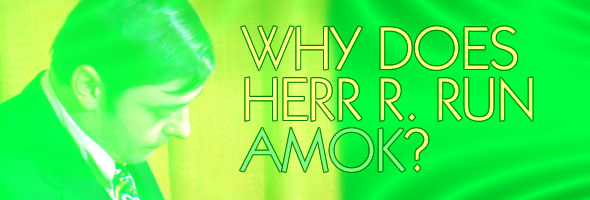

Colour, 1970, 88m. / Directed by Rainer Werner Fassbinder & Michael Fengler / Starring Kurt Raab, Lilith Ungerer, Irm Herrmann, Lilo Pempeit, Hanna Schygulla / Fantoma (US R1 NTSC)
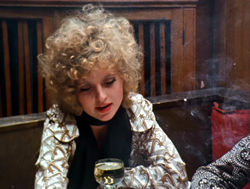 mundane events in which he lingers outside various social circles. First seen tagging with some joking co-workers, he never really connects with his wife (Ungerer) or child, while former schoolfriends, neighbors, and colleagues go about their trivial business, leaving his inner compulsion for order and control increasingly irritated. Eventually his frustrations surface, calmly but horrifically, in a violent outburst that closes the film on a particularly grim note.
mundane events in which he lingers outside various social circles. First seen tagging with some joking co-workers, he never really connects with his wife (Ungerer) or child, while former schoolfriends, neighbors, and colleagues go about their trivial business, leaving his inner compulsion for order and control increasingly irritated. Eventually his frustrations surface, calmly but horrifically, in a violent outburst that closes the film on a particularly grim note.
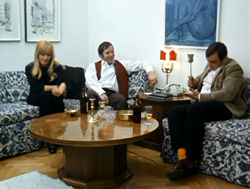 dramatically six years later as the lead in Fassbinder's Satan's Brew, which is basically a sick-joke remake of this film. Future Fassbinder muse Hanna Schygulla also pops up in a nice supporting bit as a school friend, and her warm, engaging presence is already a standout. Interestingly, Fassbinder chose to designate co-writing and co-directing credit to his friend, Michael Fengler, a status also carried over to their TV film the same year, The Niklashausen Journey. Most disturbingly, Fengler's son, Amadeus, plays Herr R.'s son without credit.
dramatically six years later as the lead in Fassbinder's Satan's Brew, which is basically a sick-joke remake of this film. Future Fassbinder muse Hanna Schygulla also pops up in a nice supporting bit as a school friend, and her warm, engaging presence is already a standout. Interestingly, Fassbinder chose to designate co-writing and co-directing credit to his friend, Michael Fengler, a status also carried over to their TV film the same year, The Niklashausen Journey. Most disturbingly, Fengler's son, Amadeus, plays Herr R.'s son without credit.
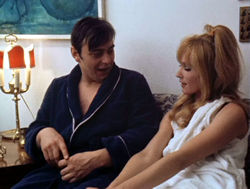 lighting and hard-edged exteriors that look especially crisp and striking here, coupled with Fassbinder's choice to shoot most of the film in detached medium shots. Note that the opening credits run very tight against the edges of the frame, so some cropping may be visible depending on your monitor's settings. Audio is presented in sharp German mono with optional English subtitles. The biggest extra is a 1992 video interview with regular Fassbinder cinematographer Dietrich Lohmann (later destined for such Hollywood fare as Deep Impact and the astonishing Color of Night), who talks about his collaborations with the tempestuos but undeniably brilliant filmmaker during the early stages of their careers together. Fassbinder scholar James Clark also contributes a nice set of liner notes exploring the various themes and questions explored by the film. (Too bad Fantoma couldn't also snag the wild, parodic 2004 short film, "Why Does Herr V. Run Amok?;" it would have made a great extra!)
lighting and hard-edged exteriors that look especially crisp and striking here, coupled with Fassbinder's choice to shoot most of the film in detached medium shots. Note that the opening credits run very tight against the edges of the frame, so some cropping may be visible depending on your monitor's settings. Audio is presented in sharp German mono with optional English subtitles. The biggest extra is a 1992 video interview with regular Fassbinder cinematographer Dietrich Lohmann (later destined for such Hollywood fare as Deep Impact and the astonishing Color of Night), who talks about his collaborations with the tempestuos but undeniably brilliant filmmaker during the early stages of their careers together. Fassbinder scholar James Clark also contributes a nice set of liner notes exploring the various themes and questions explored by the film. (Too bad Fantoma couldn't also snag the wild, parodic 2004 short film, "Why Does Herr V. Run Amok?;" it would have made a great extra!)
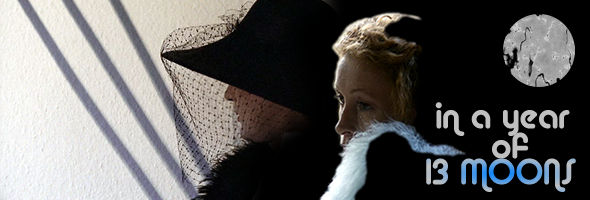
Colour, 1978, 124m. / Directed by Rainer Werner Fassbinder / Starring Volker Spengler, Ingrid Caven / Fantoma (US R1 NTSC) / WS (1.78:1) (16:9)
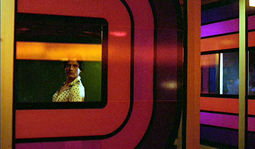 as our transgendered hero/heroine, Elvira (Spengler), is pummeled in a Frankfurt park by some thugs, you know right away it's going to be a bumpy ride. Formerly known as Erwin, Elvira decided to switch sexes in Casablanca after one unrequited love object, Anton (Gottfried John), made an offhanded comment, "Too bad you're not a girl." Of course, Erwin's drastic response proves to be a problematic course of action, not least of all for his ex-wife. Elvira befriends a prostitute, Zora (Caven), whom she escorts to her previous place of a employment, a slaughterhouse (shown in lingering, excruciating detail). She walks back through the stages of her life and eventually returns to Anton, seen in one of Fassbinder's oddest set pieces performing an impromptu dance routine with his coworkers. Not surprisingly, it all ends with tragedy and irony in equal measures.
as our transgendered hero/heroine, Elvira (Spengler), is pummeled in a Frankfurt park by some thugs, you know right away it's going to be a bumpy ride. Formerly known as Erwin, Elvira decided to switch sexes in Casablanca after one unrequited love object, Anton (Gottfried John), made an offhanded comment, "Too bad you're not a girl." Of course, Erwin's drastic response proves to be a problematic course of action, not least of all for his ex-wife. Elvira befriends a prostitute, Zora (Caven), whom she escorts to her previous place of a employment, a slaughterhouse (shown in lingering, excruciating detail). She walks back through the stages of her life and eventually returns to Anton, seen in one of Fassbinder's oddest set pieces performing an impromptu dance routine with his coworkers. Not surprisingly, it all ends with tragedy and irony in equal measures.
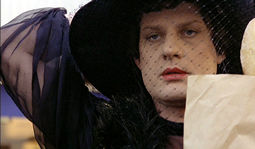 Pushing his penchant for melodrama to its most unsparing, stripped-down extremes, Fassbinder seemed determined with this film to swerve as far away as possible from the commercial success of films like The Marriage of Maria Braun. His ongoing personal issues and recent tragedies (including the death of his ex) have been cited as large contributions to this film's inception, and the result certainly isn't a happy one. As the center of the film, Spengler gives an excellent, anguished performance; his haunted face is often seen reflected in mirrors (often several at a time) and even fractured into segments in one of the film's most arresting images. Performing cinematography chores himself. Fassbinder conjures up some visually intriguing moments by framing Elvira inside trendy bar decor, against modern architecture, and from a distance within vast, antiseptic rooms, conveying the impression of a soul enclosed by its own ill-advised, emotional choices.
Pushing his penchant for melodrama to its most unsparing, stripped-down extremes, Fassbinder seemed determined with this film to swerve as far away as possible from the commercial success of films like The Marriage of Maria Braun. His ongoing personal issues and recent tragedies (including the death of his ex) have been cited as large contributions to this film's inception, and the result certainly isn't a happy one. As the center of the film, Spengler gives an excellent, anguished performance; his haunted face is often seen reflected in mirrors (often several at a time) and even fractured into segments in one of the film's most arresting images. Performing cinematography chores himself. Fassbinder conjures up some visually intriguing moments by framing Elvira inside trendy bar decor, against modern architecture, and from a distance within vast, antiseptic rooms, conveying the impression of a soul enclosed by its own ill-advised, emotional choices.
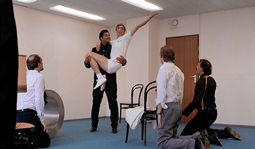 Fantoma's special edition is the most elaborate of their Fassbinder releases to date, beginning with an admiring video introduction from director Richard Linklater (School of Rock). Julianne Lorenz, Fassbinder's editor and longtime friend, contributes both a video interview and audio commentary explaining the circumstances of the film's genesis and its unique status as the director's most personal, hands-on film. Director Werner Schroeder appears for a conversational appraisal (entitled "Love and Despair"), while writer Robert Kolker contributes some incisive liner notes. The transfer looks very good throughout, though the film often has a dark, intentionally grimy look in many interior scenes. The 1.78:1 framing looks okay but a little tight at times; when played back on one 16x9 monitor, the credits skirted off the top and bottom of the screen, but on another set they barely stayed within frame (similar to the Criterion BRD trilogy). In any case, it looks much better than the old New Yorker tape and is an essential part of a Fassbinder collection. Just don't make it your first foray into his work, or you might feel too dejected to come back again!
Fantoma's special edition is the most elaborate of their Fassbinder releases to date, beginning with an admiring video introduction from director Richard Linklater (School of Rock). Julianne Lorenz, Fassbinder's editor and longtime friend, contributes both a video interview and audio commentary explaining the circumstances of the film's genesis and its unique status as the director's most personal, hands-on film. Director Werner Schroeder appears for a conversational appraisal (entitled "Love and Despair"), while writer Robert Kolker contributes some incisive liner notes. The transfer looks very good throughout, though the film often has a dark, intentionally grimy look in many interior scenes. The 1.78:1 framing looks okay but a little tight at times; when played back on one 16x9 monitor, the credits skirted off the top and bottom of the screen, but on another set they barely stayed within frame (similar to the Criterion BRD trilogy). In any case, it looks much better than the old New Yorker tape and is an essential part of a Fassbinder collection. Just don't make it your first foray into his work, or you might feel too dejected to come back again!

Colour, 1974, 115m. / Directed by Rainer Werner Fassbinder / Starring Margit Carstensen, Karlheinz Böhm / Fantoma (US R1 NTSC)
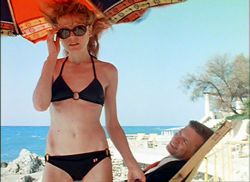 However, while Hitchcock and Truffaut successfully shoehorned Woolrich into their own palatable brand of internationally accepted entertainment, Fassbinder runs mad with the author's misanthropic tone and pushes it into even blacker territory than the cranky mystery novelist could have imagined.
However, while Hitchcock and Truffaut successfully shoehorned Woolrich into their own palatable brand of internationally accepted entertainment, Fassbinder runs mad with the author's misanthropic tone and pushes it into even blacker territory than the cranky mystery novelist could have imagined.
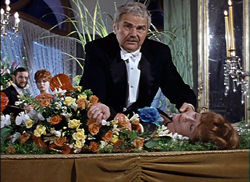 sweeps Martha away to an estate where she's forbidden to smoke (except outside on a plant-filled veranda), and he even sends in a resignation letter for her librarian job without telling her. Despite his abusive behavior, Martha refuses to admit that anything's wrong with her beloved, even when seeking help from friends. However, Helmut's sadistic tendencies spin rapidly out of control, leading Martha to believe that he might be capable of killing her.
sweeps Martha away to an estate where she's forbidden to smoke (except outside on a plant-filled veranda), and he even sends in a resignation letter for her librarian job without telling her. Despite his abusive behavior, Martha refuses to admit that anything's wrong with her beloved, even when seeking help from friends. However, Helmut's sadistic tendencies spin rapidly out of control, leading Martha to believe that he might be capable of killing her.
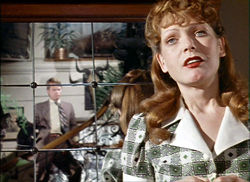 sucker punch ending that's wholly appropriate and deeply unforgiving. If you want a nice, warm story about compassionate people, go somewhere else; if you're looking for a wonderfully sick joke of a film that can still pass for respectable foreign cinema, look no further.
sucker punch ending that's wholly appropriate and deeply unforgiving. If you want a nice, warm story about compassionate people, go somewhere else; if you're looking for a wonderfully sick joke of a film that can still pass for respectable foreign cinema, look no further.
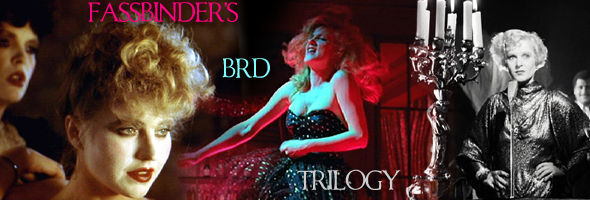
FASSBINDER'S BRD TRILOGY
THE MARRIAGE OF MARIA BRAUN
Colour, 1978, 120m. / Directed by Rainer Werner Fassbinder / Starring Hanna Schygulla, Klaus Löwitsch
LOLA
Colour, 1981, 113m. / Directed by Rainer Werner Fassbinder / Starring Barbara Sukowa, Armin Mueller-Stahl
VERONIKA VOSS
B&W, 1982, 104m. / Directed by Rainer Werner Fassbinder / Starring Rosel Zech, Hilmar Thate / Criterion (US R1 NTSC) / WS (1.66:1) (16:9)
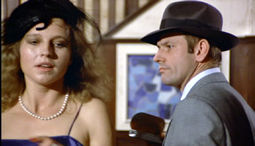 strong woman building a life after the war; often combining comedy, tragedy, and eroticism within the same story, the films dovetail nicely with each other and form a sort of loose study in the director's evolving but always distinct style.
strong woman building a life after the war; often combining comedy, tragedy, and eroticism within the same story, the films dovetail nicely with each other and form a sort of loose study in the director's evolving but always distinct style.
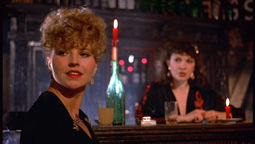
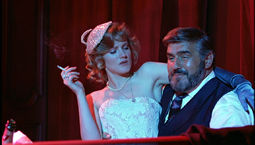 the surface, is the wild fantasia of Lola, whose title immediately announces its intentions as a riff on Josef Von Sternberg's The Blue Angel. Here our capitalistic siren, played by Barbara Sukowa (M. Butterfly), is a nightclub performer and whore in the service of wealthy, cheerfully decadent Schukert (The Bird with the Crystal Plumage's Mario Adorf), with whom she has a child out of wedlock. Enter morally pure Von Bohm (Armin Mueller-Stahl), a building commissioner who threatens Schuckert's financial grip on the city. On a bet with her patron, Lola plays innocent and sets out to seduce Von Bohm, who falls in love with her. However, the interplay of emotions and money prove to be more complicated than either of them imagined.
the surface, is the wild fantasia of Lola, whose title immediately announces its intentions as a riff on Josef Von Sternberg's The Blue Angel. Here our capitalistic siren, played by Barbara Sukowa (M. Butterfly), is a nightclub performer and whore in the service of wealthy, cheerfully decadent Schukert (The Bird with the Crystal Plumage's Mario Adorf), with whom she has a child out of wedlock. Enter morally pure Von Bohm (Armin Mueller-Stahl), a building commissioner who threatens Schuckert's financial grip on the city. On a bet with her patron, Lola plays innocent and sets out to seduce Von Bohm, who falls in love with her. However, the interplay of emotions and money prove to be more complicated than either of them imagined. 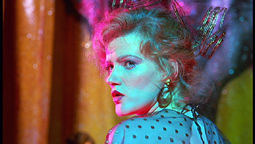 is a stylist's dream come true. Characters are constantly bathed in particular shades to emphasize their moral condition: Lola equals red, Von Bohm equals blue, and so on. Scene transitions are usually accomplished with elaborate dissolves in and out of focus, and the constant flow of cigarette smoke provides an appropriately gauzy visual texture. For some reason Sukowa remains one of the less internationally renowned actresses, which is a shame; she really cuts loose here with a magnetic performance, including one musical freak-out that gives Ann-Margret a run for her money. In a twisted sense, this is also one of Fassbinder's more cheerful films; the characters celebrate their corruption and infidelities, and as the seemingly incorruptible hero finds his scruples eroding with Lola's influence, the film closes on an ironic "happy" note whose consequences are left to be addressed in the viewer's mind.
is a stylist's dream come true. Characters are constantly bathed in particular shades to emphasize their moral condition: Lola equals red, Von Bohm equals blue, and so on. Scene transitions are usually accomplished with elaborate dissolves in and out of focus, and the constant flow of cigarette smoke provides an appropriately gauzy visual texture. For some reason Sukowa remains one of the less internationally renowned actresses, which is a shame; she really cuts loose here with a magnetic performance, including one musical freak-out that gives Ann-Margret a run for her money. In a twisted sense, this is also one of Fassbinder's more cheerful films; the characters celebrate their corruption and infidelities, and as the seemingly incorruptible hero finds his scruples eroding with Lola's influence, the film closes on an ironic "happy" note whose consequences are left to be addressed in the viewer's mind. 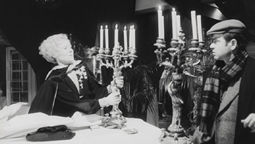 black-and-white Germany whose appearance resembles the glittering surfaces of a Von Sternberg film; unfortunately something is very rotten underneath. A former UFA cinema star, Veronika (Rosel Zech) runs into reporter Robert (Hilmar Thate) during a rainstorm and, after a reluctant bus ride, accompanies him home for a halfhearted tryst. Her star rapidly falling, Veronika has not fared well since the war and, even worse, has become addicted to morphine thanks to the questionable medical practices of her physician, Dr. Katz (Annemarie Düringer). Unfortunately Veronika's attempts at a comeback do not fare well, and Robert's earnest quest to end the corrupt doctor's plans also encounters a few nasty snags.
black-and-white Germany whose appearance resembles the glittering surfaces of a Von Sternberg film; unfortunately something is very rotten underneath. A former UFA cinema star, Veronika (Rosel Zech) runs into reporter Robert (Hilmar Thate) during a rainstorm and, after a reluctant bus ride, accompanies him home for a halfhearted tryst. Her star rapidly falling, Veronika has not fared well since the war and, even worse, has become addicted to morphine thanks to the questionable medical practices of her physician, Dr. Katz (Annemarie Düringer). Unfortunately Veronika's attempts at a comeback do not fare well, and Robert's earnest quest to end the corrupt doctor's plans also encounters a few nasty snags. (or, if you prefer, one woman under three different names), they could also easily be read as a sardonic commentary on the role of success and celebrity in a more disillusioned era. The first film follows a rise to power, a capitalist climb with an ultimate disillusionment; the second depicts the height of excess and success, an orgy of color and corruption; the third, sapped of color, casts a mirror back at the past and follows the decline of fame and fortune. Of course, the parallels to Fassbinder himself are unmistakable; Maria Braun found him at the peak of critical acclaim, a rising force in the film world with a stable of actors. Lola finds indulging in gleeful directorial excess of the highest order, like Douglas Sirk on acid. By the time of Veronika Voss, his penultimate film, his drug addiction was about to claim his life. Each film also offers the opportunity to witness the Fassbinder crew at various stages, particularly composer Peer Raben; his triptych of scores represents a beautiful contrast in styles, integrating Germany's music hall and theatrical heritage into a beautiful group of orchestral scores.
(or, if you prefer, one woman under three different names), they could also easily be read as a sardonic commentary on the role of success and celebrity in a more disillusioned era. The first film follows a rise to power, a capitalist climb with an ultimate disillusionment; the second depicts the height of excess and success, an orgy of color and corruption; the third, sapped of color, casts a mirror back at the past and follows the decline of fame and fortune. Of course, the parallels to Fassbinder himself are unmistakable; Maria Braun found him at the peak of critical acclaim, a rising force in the film world with a stable of actors. Lola finds indulging in gleeful directorial excess of the highest order, like Douglas Sirk on acid. By the time of Veronika Voss, his penultimate film, his drug addiction was about to claim his life. Each film also offers the opportunity to witness the Fassbinder crew at various stages, particularly composer Peer Raben; his triptych of scores represents a beautiful contrast in styles, integrating Germany's music hall and theatrical heritage into a beautiful group of orchestral scores. 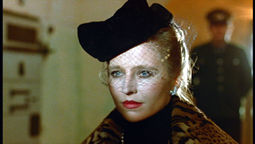 may result in some peculiar framing during the opening credits for each film; Fassbinder uses the odd device of repeating the names numerous times across the screen in linear strips, with portions of information deliberately running off the screen. Naturally Lola is the most dramatic piece of the set; its ultra-gaudy colors look magnificent and certainly surpass the smeary VHS transfers found in Europe. (Inexplicably, this is the film's first-ever appearance on American video.)
may result in some peculiar framing during the opening credits for each film; Fassbinder uses the odd device of repeating the names numerous times across the screen in linear strips, with portions of information deliberately running off the screen. Naturally Lola is the most dramatic piece of the set; its ultra-gaudy colors look magnificent and certainly surpass the smeary VHS transfers found in Europe. (Inexplicably, this is the film's first-ever appearance on American video.) 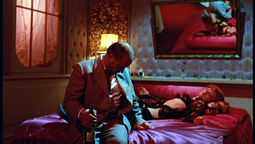 friend Christian Braad Thomsen; it's an extremely factual and structured talk, with very few conversational asides, and offers some good insights into the visual construction of the film despite Thomsen's extremely strong accent. (This commentary works best in separate chunks than a continuous experience.) Sukowa turns up for a welcome video interview in which she charts the elaborate process of how she came to work for Fassbinder in Berlin Alexanderplatz and how Lola came to be. Fassbinder co-writer Peter Märthesheimer appears for a separate video interview, explaining his own collaborative experiences. Veronika Voss features a commentary with Fassbinder scholar (how many are there anyway?) Tony Rayns, who covers the latter stages of the director's life and discusses the various cultural influences on the film. A fine companion piece to the commentary (best viewed afterwards) is a one-hour documentary, Dance with Death (Tanz mit dem Tod), about the life of UFA actress Sybille Schmitz (Vampyr), whose tragic life was more or less the inspiration for this film. Video conversations with Zech and editor Juliane Lorenz also cover the making of the film, focusing on how the amazing period look and feel was created through performance and pacing.
friend Christian Braad Thomsen; it's an extremely factual and structured talk, with very few conversational asides, and offers some good insights into the visual construction of the film despite Thomsen's extremely strong accent. (This commentary works best in separate chunks than a continuous experience.) Sukowa turns up for a welcome video interview in which she charts the elaborate process of how she came to work for Fassbinder in Berlin Alexanderplatz and how Lola came to be. Fassbinder co-writer Peter Märthesheimer appears for a separate video interview, explaining his own collaborative experiences. Veronika Voss features a commentary with Fassbinder scholar (how many are there anyway?) Tony Rayns, who covers the latter stages of the director's life and discusses the various cultural influences on the film. A fine companion piece to the commentary (best viewed afterwards) is a one-hour documentary, Dance with Death (Tanz mit dem Tod), about the life of UFA actress Sybille Schmitz (Vampyr), whose tragic life was more or less the inspiration for this film. Video conversations with Zech and editor Juliane Lorenz also cover the making of the film, focusing on how the amazing period look and feel was created through performance and pacing. 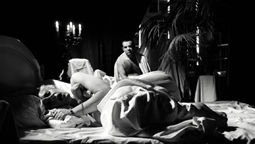

Colour, 1974, 93m. / Directed by Rainer Werner Fassbinder / Starring Brigitte Mira, El Hedi ben Salem / Criterion (US R1 NTSC)
 clearly Ali: Fear Eats the Soul (Angst essen Seele auf), a dazzling reinterpreation of All That Heaven Allows which throws in age and racial differences onto the already volatile story of love ripped apart by class divisions.
clearly Ali: Fear Eats the Soul (Angst essen Seele auf), a dazzling reinterpreation of All That Heaven Allows which throws in age and racial differences onto the already volatile story of love ripped apart by class divisions.
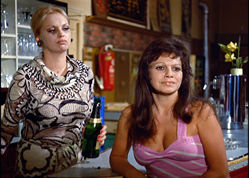 Despite their reputation as austere and often difficult to enjoy, Fassbinder's films are actually quite engaging and rewarding as long as one doesn't necessarily expect a traditional Hollywood ending. One of his most accessible films, Ali benefits from extremely rich and realistic characters whose plight elicits a number of powerful emotional responses. The spectacular two lead performances are the greatest assets; amazingly, Mira would go on to nearly equal her work here one year later in Mother Küsters Goes to Heaven. As usual Fassbinder's use of the camera to frame his characters and their striking, angular environments is without peer, and here we really see him developing the dynamic, stylized use of color which would explode in such later films as Lola and Querelle. Whether seen as a tearjerker, social statement, or artistic experiment, Fassbinder's masterpiece works perfectly and remains sadly relevant, regardless of the passage of time or the country of origin.
Despite their reputation as austere and often difficult to enjoy, Fassbinder's films are actually quite engaging and rewarding as long as one doesn't necessarily expect a traditional Hollywood ending. One of his most accessible films, Ali benefits from extremely rich and realistic characters whose plight elicits a number of powerful emotional responses. The spectacular two lead performances are the greatest assets; amazingly, Mira would go on to nearly equal her work here one year later in Mother Küsters Goes to Heaven. As usual Fassbinder's use of the camera to frame his characters and their striking, angular environments is without peer, and here we really see him developing the dynamic, stylized use of color which would explode in such later films as Lola and Querelle. Whether seen as a tearjerker, social statement, or artistic experiment, Fassbinder's masterpiece works perfectly and remains sadly relevant, regardless of the passage of time or the country of origin.
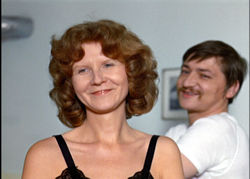 who discusses his film school exposure to Sirk, outlines the Sirk influence on both quasi-remakes, and defends a genre once spat upon by cineastes. A 2003 short film entitled "Angst isst Seele auf" (a more grammatically correct version of the film's title) takes place entirely from the point of view of a dark-skinned Arab in Germany, encountering violent neo-Nazis before stepping into a live theatrical production of Ali with Mira reprising her role. The short is presented in anamorphic widescreen, framed at 1.78:1. Mira also turns up for a new 22-minute video interview and comes across as extremely sharp and witty; she makes for charming, candid company and discusses how Fassbinder's approach revolutionized her acting career. Longtime Fassbinder editor Thea Eymèsz also appears for a separate interview, running 21 minutes, in which she discusses the professional working relationship she cultivated with the director and traces how his approach evolved over time before his premature death. "Signs of Vigourous Life: New German Cinema" is a 32-minute BBC program from 1976 which offers an overview of the rising directorial talents in Germany; Fassbinder doesn't really enter the picture until halfway through and is covered mainly through stills and second hand narration, while Werner Herzog is interviewed and receives the lion's share of screen time. The final extra is a snippet from Fassbinder's earlier The American Soldier, in which a character quickly relates the story of Emmi and Ali with a far more brutal conclusion than the one Fassbinder ultimately chose.
who discusses his film school exposure to Sirk, outlines the Sirk influence on both quasi-remakes, and defends a genre once spat upon by cineastes. A 2003 short film entitled "Angst isst Seele auf" (a more grammatically correct version of the film's title) takes place entirely from the point of view of a dark-skinned Arab in Germany, encountering violent neo-Nazis before stepping into a live theatrical production of Ali with Mira reprising her role. The short is presented in anamorphic widescreen, framed at 1.78:1. Mira also turns up for a new 22-minute video interview and comes across as extremely sharp and witty; she makes for charming, candid company and discusses how Fassbinder's approach revolutionized her acting career. Longtime Fassbinder editor Thea Eymèsz also appears for a separate interview, running 21 minutes, in which she discusses the professional working relationship she cultivated with the director and traces how his approach evolved over time before his premature death. "Signs of Vigourous Life: New German Cinema" is a 32-minute BBC program from 1976 which offers an overview of the rising directorial talents in Germany; Fassbinder doesn't really enter the picture until halfway through and is covered mainly through stills and second hand narration, while Werner Herzog is interviewed and receives the lion's share of screen time. The final extra is a snippet from Fassbinder's earlier The American Soldier, in which a character quickly relates the story of Emmi and Ali with a far more brutal conclusion than the one Fassbinder ultimately chose.
Color, 1982, 108m. / Directed by Rainer Werner Fassbinder / Starring Brad Davis, Franco Nero / Columbia (US R1 NTSC), Second Sight (UK R2 PAL) / WS (2.35:1) (16:9) Color, 1971, 84m. / Directed by Rainer Werner Fassbinder / Starring Hanna Schygulla, Harry Baer / Fantoma (US R1 NTSC) Color, 1971, 95 mins. / Directed by Rainer Werner Fassbinder / Starring Günther Kaufmann, Ron Randell, Hanna Schygulla, Katrin Schaake, Harry Bär, Ulli Lommel / Music by Peer Raben / Cinematography by Michael Ballhaus Format: DVD - Fantoma (MSRP $29.95) / Letterboxed (2.35:1) / Dolby Digital Mono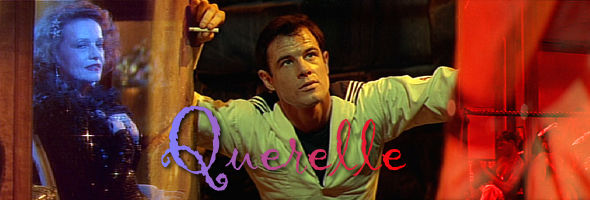
Four years after escaping from both a Turkish prison and a potential change of sexual orientation in the shower room in Midnight Express, late actor Brad Davis went over the edge in Querelle, the last film by Rainer Werner Fassbinder, who died of a drug overdose before the film's US premiere. The director's most blatantly homoerotic work (to put it mildly), Querelle throws aside the touchy gay politics of realistic studies like Fox and His Friends in favor of what can only be described as a hellish, horny mixture of Heironymous Bosch and Kwaidan. Derived more or less from a novel by revered thief/poet/novelist Jean Genet (who also inspired Poison and The Balcony), the fractured story follows the misadventures of Querelle (Davis), a sexually undecided sailor who winds up at a port in Brest and encounters a variety of colorful characters, including his brother, Robert (Hanno Pöschl), who is having an affair with saloon owner and singer Lysiane (Jeanne Moreau). Meanwhile her burly black husband, Nono (Günther Kaufmann), sets his sights on Querelle, whose lust is temporarily distracted when he impulsively knifes a fellow sailor to death and diverts the blame to Gil (Pöschl with different facial hair), a murderous criminal with whom Querelle begins to fall in love. Meanwhile Querelle's commanding officer, Seblon (Franco Nero), lusts from afar and begins devising his own agenda.
Upon its release, Querelle was critically scorned (especially in the US) for its jolting and deliberately artificial storytelling technique, which regularly punctuates the action with rambling voiceovers and onscreen quotations from Genet and other seemingly random sources. Davis' performance deliberately turns Querelle into a blank slate upon which the other characters project their desires; the crafty, intense charm which made him famous is transformed here into a casually voracious presence, whether engaging in choreographed knife and fist fights or lolling around in a different character's bed every night. While Nero has virtually nothing to do but gaze intensely from afar, Moreau fares better (in her second Genet adaptation after the underrated and startling Mademoiselle) thanks to her ability to give poignancy to even the silliest lines and lyrics. The studio sets used to represent Brest are a visual feast of blazing oranges, reds, and yellows, which can make the whole experience queasy after a while but certainly give the film a distinctive, unforgettable look. From the phallic statue formations to the corruptively ripe saloon interiors, this is Fassbinder in full throttle, choking the screen with as much overstuffed excess as he can possibly muster.
For those unfortunate enough to suffer through Columbia's old pan and scan VHS transfer, Querelle on DVD will look like a different film entirely. Fassbinder uses the entire scope frame to experiment with bizarre angles, distorting lenses, and deeply layered compositions and tableux, while the saturated colors which bleed all over the screen on videotape look more refined and tolerable here. The anamorphic transfer provided by Gaumont most likely comes from a PAL source, and for some reason in 16:9 playback the image looked a bit coarse and noisy (as if suffering from excessive digital noise reduction), while on another widescreen monitor it looked perfectly smooth and glossy. If it looks a little odd on your television, you might want to try another. The end titles sport a Dolby Stereo tag, though the film is presented in mono in both English and French. Davis, Moreau, and Nero provide their own voices, while virtually all of the other actors are very artificially dubbed in a manner that may cause even diehard Italian horror fans to bristle with annoyance. The alternate French track (which can be played with optional English, Spanish, or French subtitles) is a little easier on the ears, but it also suppresses or eliminates altogether most of the sound effects and music. (The UK disc from Second Sight is letterboxed but only retains the English dubbed option.) This unrated edition also runs about two minutes longer than the US edition; while there's still virtually no nudity in the film per se, a few sequences (such as Davis' forced manual stimulation of another sailor at knifepoint) are more explicit and may not have been faked. Inexplicably, the US disc's only supplements are trailers for The Opposite of Sex and sex, lies and videotape, which might give you an idea of where the marketing people are coming from.
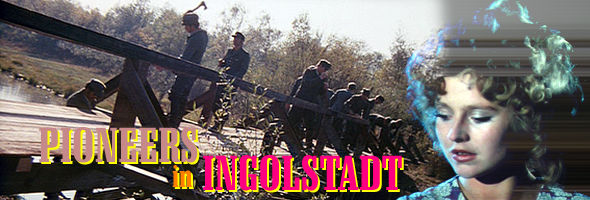
Though best known for his visually florid, emotionally overwrought warscapes like The Bitter Tears of Petra von Kant and The Marriage of Maria Braun, the prolific and self-destructive Rainer Werner Fassbinder began his career with low key, downbeat portraits in kitchen sink realism like Why Does Herr R. Run Amok? and The Gods of the Plague, whose titles give a fairly clear idea of their emotional timbre. In this respect, Pioneers in Ingolstadt is a pivotal work, sandwiched in between these two periods and offering a sort of backward glance at the style he was soon to leave behind.
Over the credits we witness the processional arrival of a group of military engineers and laborers into the small town of Ingolstadt, where the citizens await the construction of bridge which will unite it more directly with the rest of the country. The women in particular take a liking to the new male arrivals, with young Berta (Hanna Schygulla) taking a particular liking to the handsome Karl (Harry Baer). Meanwhile the sole black soldier, Max (Günther Kaufmann), becomes the object of desire for more than a few women. Soon simple evenings spent at the local taverns become fraught with sexual interplay and suspicion, leaving the town marked forever in the name of progress.
An emotionally subdued work by Fassbinder standards, Pioneers could almost pass for a small scale, early Werner Herzog film instead. Most of the sex takes place offscreen and remains confined to longing looks and erotically charged discussions on benches; the joy, of course, comes instead from watching the director's regular stable of performers at their height. As usual Schygulla steals the show and proves her worth as one of international cinema's greatest performers; she could simply file her nails for 90 minutes and make the experience fascinating.
Considering it has almost been completely forgotten in light of Fassbinder's later films, Pioneers seems to have been given a second lease on life via the magic of DVD. No one will be likely to peg the film a masterpiece, but it's exceptionally direct and finely tuned from start to finish, making it a fascinating experience for those with an adventurous taste for moviegoing. As with most of Fassbinder's early, low budget efforts, the image quality varies wildly depending on the film stock and lighting at hand, made all the more erratic by the fact this was evidently lensed in 16mm and intended for German television. DVD fanatics may bristle during the opening credits, in which the optical processing necessary to layer the titles has rendered the image with a strong blanket of haze and grain. However, things improve about five minutes in once we switch indoors, and from there onward the material is pleasantly colorful and clean. The optional yellow English subtitles move at a good speed and are well articulated throughout. The rest of the extras are understandably limited, consisting of a Fassbinder filmography and excellent, thorough liner notes by Chuck Stephens. For an interesting comparison at just how much Fassbinder's available means increased within the span of less than one year, take a look (review below) at Fantoma's DVD of Whity (issued later in 1971), a glossy, Cinemascope riot of boisterous colors and articificial sets. Even for those who dislike Fassbinder's work, there's no denying that his versatility as an artist could be astonishing.
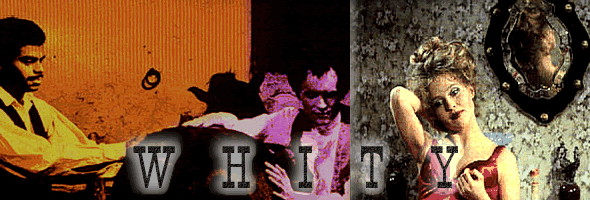
In his relatively brief lifespan, controversial and undeniably gifted director Rainer Werner Fassbinder churned out over forty films before overdosing in 1982, and his work managed to hit the mark more often than not. He started out in the '60s doing gritty "slice of life" films like Gods of the Plague, none of which were especially cheerful. However, beginning with the rarely seen musical western Whity, he turned towards a more stylized, formal approach which emphasized color, set design, absurd plot twists, and of course, melodrama. Rarely screened outside Germany, Whity nevertheless caught on as a familiar title among the art house crowd, particularly after Fassbinder distilled its tumultuous production history into the story of another film, Beware of a Holy Whore.
Set in the late 1800s, this perverse epic takes place in the Southwestern household of Ben Nicholson (Ron Randell, the former Bulldog Drummond) and his highly disturbed family. Ben's trophy wife, the blonde Katherine (Katrin Schaake), sleeps with almost anything that moves, while his sons are either
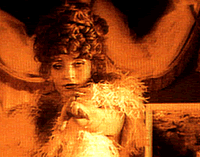 outrageously gay (Ulli Lommel) or mentally handicapped (Harry Bär). Each family member is fixated in a different way on Whity (Günther Kaufmann, Fassbinder's occasional lover and regular actor), the mulatto servant who tends to their pathetic needs. Whity's mother (Elaine Baker) is content to be a stereotypical "mammy" figure, but Whity has other plans, mostly involving his love for the sultry saloon singer, Hanna (the always magnificent Hanna Schygulla). After Ben reads his will aloud to the family (the film's most astounding scene), each member of the clan's demands on Whity escalate out of control to a murderous finale.
outrageously gay (Ulli Lommel) or mentally handicapped (Harry Bär). Each family member is fixated in a different way on Whity (Günther Kaufmann, Fassbinder's occasional lover and regular actor), the mulatto servant who tends to their pathetic needs. Whity's mother (Elaine Baker) is content to be a stereotypical "mammy" figure, but Whity has other plans, mostly involving his love for the sultry saloon singer, Hanna (the always magnificent Hanna Schygulla). After Ben reads his will aloud to the family (the film's most astounding scene), each member of the clan's demands on Whity escalate out of control to a murderous finale.So bizarre that it can't even really be considered offensive, Whity twists the entire notion of American race relations and western cliches to create something entirely unearthly. The white cast members all sport bleached ivory make up, giving them the appearance of walking corpses, while Whity's mother sports a traditional and often alarming blackface. Whity himself and Hanna retain their natural skin tones, as do a few supporting characters (including R.W. himself in an amusing uncredited bit as a gunslinging barfly). Filmed on the same Spanish sets used for Sergio Leone's spaghetti westerns, this is truly an amazing looking film, saturated with vibrant colors even in the darkest scenes, and the cinematography by Michael Ballhaus (who later worked with Scorsese, Coppolla, and many others) is never less than masterful. The actors do what they can under the circumstances, considering each character is insane and on edge in almost every scene.
While Fantoma had understandably flawed source materials to work with for their maiden effort, Jodorowsky's Fando and Lis, they had no such difficulties here. Whity is simply one of the most startling color transfers to DVD so far, with hues so vibrant they put many MGM musicals to shame. The slow pacing of the film itself may not be to everyone's taste, but from a technical aspect, this disc is a stunner. The anamorphic image preserves the original Cinemascope framing, which lends an appropriate visually expansive flavor to this tawdry tale. The optional English subtitles are easily legible and synched well with the dialogue, though it appears that at least several portions of the film (Randell's scenes in particular) were shot in English and later dubbed into German. Several songs are also presented with British singers overdubbing the actors, resulting in a very odd and often incongruous soundtrack. However, the audio itself is very clear and does a fine job of showcasing the melancholy music score by the great Peer Raben. Ballhaus and Lommel (who later turned director with films like The Boogeyman) provide a fascinating audio commentary track which covers not only this film but the entire experience of working with Fassbinder. They remain appropriately sketchy about some of the more sordid, operatic aspects of the director's working patterns, but anyone interested should find plenty to chew on here. They also make some funny observations along the way, such as Lommel's comments during his character's seduction of Whity while dressed up in slinky Victoria's Secret undies.